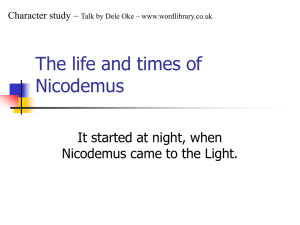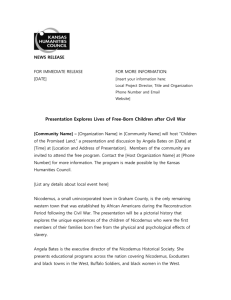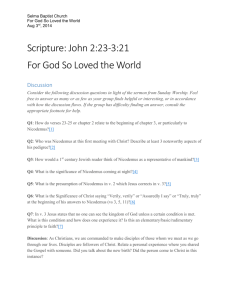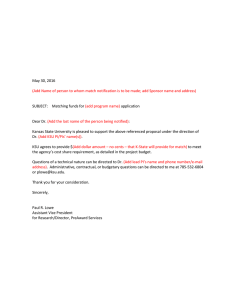Kansas State University Excellence in Engagement Award
advertisement
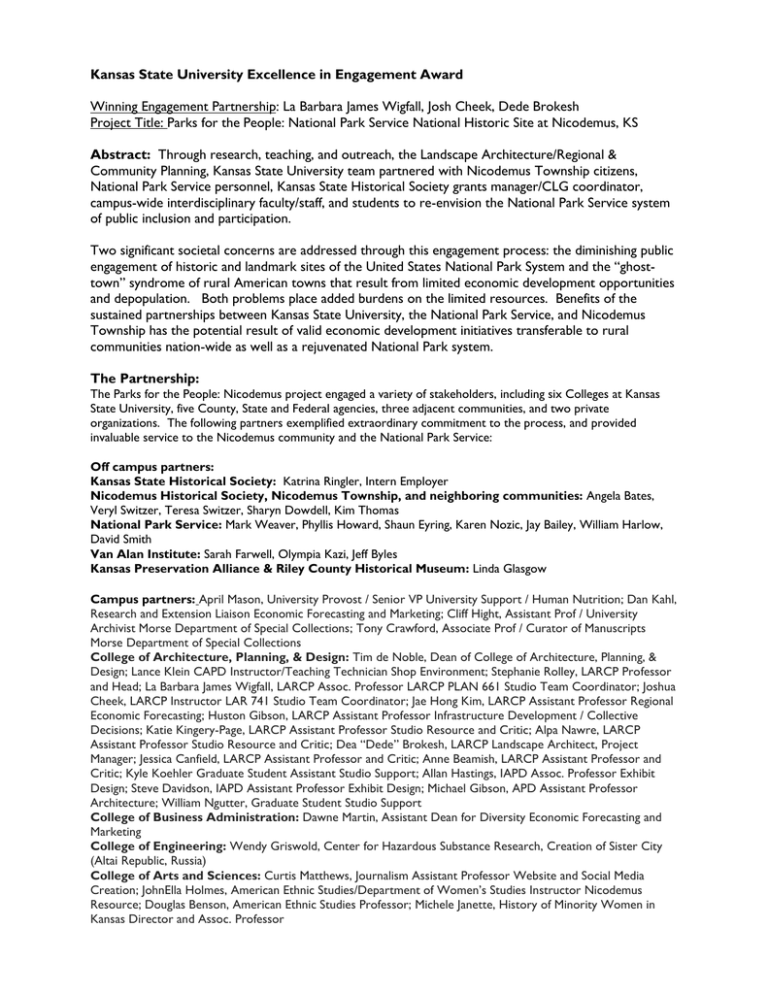
Kansas State University Excellence in Engagement Award Winning Engagement Partnership: La Barbara James Wigfall, Josh Cheek, Dede Brokesh Project Title: Parks for the People: National Park Service National Historic Site at Nicodemus, KS Abstract: Through research, teaching, and outreach, the Landscape Architecture/Regional & Community Planning, Kansas State University team partnered with Nicodemus Township citizens, National Park Service personnel, Kansas State Historical Society grants manager/CLG coordinator, campus-wide interdisciplinary faculty/staff, and students to re-envision the National Park Service system of public inclusion and participation. Two significant societal concerns are addressed through this engagement process: the diminishing public engagement of historic and landmark sites of the United States National Park System and the “ghosttown” syndrome of rural American towns that result from limited economic development opportunities and depopulation. Both problems place added burdens on the limited resources. Benefits of the sustained partnerships between Kansas State University, the National Park Service, and Nicodemus Township has the potential result of valid economic development initiatives transferable to rural communities nation-wide as well as a rejuvenated National Park system. The Partnership: The Parks for the People: Nicodemus project engaged a variety of stakeholders, including six Colleges at Kansas State University, five County, State and Federal agencies, three adjacent communities, and two private organizations. The following partners exemplified extraordinary commitment to the process, and provided invaluable service to the Nicodemus community and the National Park Service: Off campus partners: Kansas State Historical Society: Katrina Ringler, Intern Employer Nicodemus Historical Society, Nicodemus Township, and neighboring communities: Angela Bates, Veryl Switzer, Teresa Switzer, Sharyn Dowdell, Kim Thomas National Park Service: Mark Weaver, Phyllis Howard, Shaun Eyring, Karen Nozic, Jay Bailey, William Harlow, David Smith Van Alan Institute: Sarah Farwell, Olympia Kazi, Jeff Byles Kansas Preservation Alliance & Riley County Historical Museum: Linda Glasgow Campus partners: April Mason, University Provost / Senior VP University Support / Human Nutrition; Dan Kahl, Research and Extension Liaison Economic Forecasting and Marketing; Cliff Hight, Assistant Prof / University Archivist Morse Department of Special Collections; Tony Crawford, Associate Prof / Curator of Manuscripts Morse Department of Special Collections College of Architecture, Planning, & Design: Tim de Noble, Dean of College of Architecture, Planning, & Design; Lance Klein CAPD Instructor/Teaching Technician Shop Environment; Stephanie Rolley, LARCP Professor and Head; La Barbara James Wigfall, LARCP Assoc. Professor LARCP PLAN 661 Studio Team Coordinator; Joshua Cheek, LARCP Instructor LAR 741 Studio Team Coordinator; Jae Hong Kim, LARCP Assistant Professor Regional Economic Forecasting; Huston Gibson, LARCP Assistant Professor Infrastructure Development / Collective Decisions; Katie Kingery-Page, LARCP Assistant Professor Studio Resource and Critic; Alpa Nawre, LARCP Assistant Professor Studio Resource and Critic; Dea “Dede” Brokesh, LARCP Landscape Architect, Project Manager; Jessica Canfield, LARCP Assistant Professor and Critic; Anne Beamish, LARCP Assistant Professor and Critic; Kyle Koehler Graduate Student Assistant Studio Support; Allan Hastings, IAPD Assoc. Professor Exhibit Design; Steve Davidson, IAPD Assistant Professor Exhibit Design; Michael Gibson, APD Assistant Professor Architecture; William Ngutter, Graduate Student Studio Support College of Business Administration: Dawne Martin, Assistant Dean for Diversity Economic Forecasting and Marketing College of Engineering: Wendy Griswold, Center for Hazardous Substance Research, Creation of Sister City (Altai Republic, Russia) College of Arts and Sciences: Curtis Matthews, Journalism Assistant Professor Website and Social Media Creation; JohnElla Holmes, American Ethnic Studies/Department of Women’s Studies Instructor Nicodemus Resource; Douglas Benson, American Ethnic Studies Professor; Michele Janette, History of Minority Women in Kansas Director and Assoc. Professor College of Agriculture: Ted Cable, Department of Horticulture, Forestry, and Recreation Resources Assistant Department Head Heritage Interpretation and Park Design College of Human Ecology: Barbara Anderson, Department of Apparel, Textiles, and Interior Design Department Head/Associate Professor Historic Preservation Guidelines; Jane Marshall, Department of Hospitality Management and Dietetics Assistant Instructor Food Culture and History; Karen Roberts, Assistant Professor Family History and Interpretation; Kimmery Newsom, PhD candidate Human Ecology K-State Student Resources and Organizations: James Rico, Social Science and Psychology Broadcast Media and Videography; NOMAS National Organization of Minority Architecture Students; Robert Nelson, Ron Jones, Larry Jackson, and Larry Havenstein, Division of Communications & Marketing The University is committed to a long-term relationship to engage the residents of Nicodemus and surrounding towns in developing community sustainability strategies including economic stability and its physical manifestation. As noted in KSU Provost Dr. April Mason’s letter to the Van Alen Institute on Nov. 1, 2011, “Kansas State University is…positioned to commit its resources to the short-term and long-term development of citizen-lead growth strategies for Nicodemus, Kansas and the National Park Service.” In the spirit of Provost Mason’s statement, the University selected our KSU team to receive an Academic Excellence Fund award that provided additional project support. The specific Parks for the People partnership began Fall semester 2011 with submission of Phase 2 competition data in Summer 2012. Twenty faculty from multiple campus departments and 41 students in 5 LARCP courses participated in the process. LARCP students were combined to form 6 distinct teams to study overarching themes that impact the National Park Service system as a whole as well as specific outcomes at Nicodemus. Over 7200 hours of service was provided for this project. Campus, community, National Park Service, Kansas State Historical Society, and Kansas Preservation Alliance partners worked together to understand the history and sometimes-divergent goals of all stakeholders and to develop solutions for increased community viability and vibrancy. During this engaged process, partners accomplished the following: 1. KSU teams organized and participated in (3) town hall meetings, site visits, and presentations at Nicodemus and the National Historic site in Nicodemus 2. KSU teams organized and participated in two cultivation team meetings on campus where Mark Weaver, NPS Park Superintendent and JohnElla Holmes, instructor KSU American Ethnic Studies met with students to analyze and critique design and planning concepts for the Nicodemus Historic Site and Nicodemus community 3. An on-campus mid-crit was hosted by LARCP that included campus faculty/staff partners, Nicodemus citizens, and invited guests from Washington DC, New York City, Philadelphia (Northeast Region NPS), Omaha (Mid-West Region NPS), and NPS officers and affiliates. This town hall meeting with Nicodemus citizens, NPS partners, KSU faculty, and student leaders ultimately resulted in a broader approach and an expanded program that included nation-wide and local strategies for NPS system enhancements. 4. An on-campus Nicodemus Colloquium was hosted by LARCP to immerse students, faculty, and staff in historic perspectives of Nicodemus and its region. KSU faculty saw the living history performance first in Nicodemus and wanted to expose students to this experience. Following the colloquium, a cultivation meeting was held with Nicodemus citizens, faculty, and students to further discuss design and planning possibilities at the site. 5. With support from the Kansas Preservation Alliance, Kansas State Historic Society employed a KSU student in their office in Topeka to organize digital records of Nicodemus/Graham County. This partnership provided a venue for research to supplement design and planning work being performed by students, faculty, and staff on the Manhattan campus. 6. The National Park Service awarded and supervised a KSU student intern to work at the Nicodemus National Historic site, Summer 2012, in order to coalesce the design and planning strategies of the KSU and New York City College teams. The student began a synthesized written document, investigated a software application, and organized the Homecoming activities. 7. Six student teams proposed economic development strategies for Nicodemus and the National Park Service. The students presented their findings and concepts with the student intern at the Nicodemus National Historic site this summer in the categories of The Russian Altai Connection, Digital Communications/Technology, Food, Homecoming, Camps & Festivals, and Second Life. Lessons Learned and Best Practices Challenges encountered by the university and community partners included the serious economic limitations faced by many rural small-towns – limited economic opportunities, depopulation, and a stagnant public process. The KSU partners addressed these challenges by actively engaging the stakeholders of Nicodemus and National Park Service stakeholders through town hall meetings, follow up telephone conversations, and on-campus critique sessions of proposals in progress. Benefits that have emerged through this process have been the following: 1. team development of multiple on-campus and off-campus partners 2. community buy-in of university commitment 3. In a sign of “threading the needle” between the National Park Service and the community, competing interests found merits in multiple proposals and came to a consensus on the benefits of several proposals. 4. student buy-in of community interest and their welcoming attitude towards KSU students, faculty, and staff 5. Follow-up opportunities for future grant proposals with these formed partnerships can help implement the strategies identified through this process 6. The knowledge created: a. A better understanding of NPS and local citizenry needs. b. A better understanding of the nationally significant African-American history of Kansas. c. Parallels gleaned for similar small communities nation-wide that could impact future projects. 7. Potential Next Steps a. Provide a brief comparison of Nicodemus Parks for the People November 1, 2011 proposal with Nicodemus Parks for the People final presentation June 2012 in order to identify potential future proposed work. b. Core KSU team partnered with additional faculty and Nicodemus stakeholders to pursue a $584,000 ArtPlace grant to implement a performing arts pavilion, nine interpretive history site art pieces, and enhance an historic re-enactment performing arts program. Although not approved for phase 2 submission, we are pursuing other venues for funding of this economic development project. Additionally, we seek funding for a project to convert boxcars to Homecoming housing as well as funding to consolidate the two Parks for the People/Nicodemus competition submissions from KSU and New York City College. c. Build site models and websites to inform stakeholders of the design process d. Fabricate a series of exhibits and constructs that convey design information and products e. Potential short-term partners: Kansas African American Legislative Caucus; 18th and Vine Jazz District/American Jazz Museum; Negro Leagues Baseball Museum; Boy Scouts of America; Kansas Preservation Alliance; KSU National Organization of Minority Architecture Students (NOMAS); College of Agriculture – Minorities in Agriculture, Natural Resources & Related Sciences (MANRRS); College of Arts & Sciences – History Department/Chapman Center for Rural Studies, Women’s Studies Department f. Potential long-term partners: Tennessee Department of Tourist Development; Missouri Division of Tourism; Kentucky Tourism, Arts & Heritage; Smithsonian National Museum of African American History & Culture; Walt Disney Family Museum & Disney Imagineering; Boy Scouts of America; College of Engineering – Biological and Agricultural Engineering, Architectural Engineering, Civil Engineering
